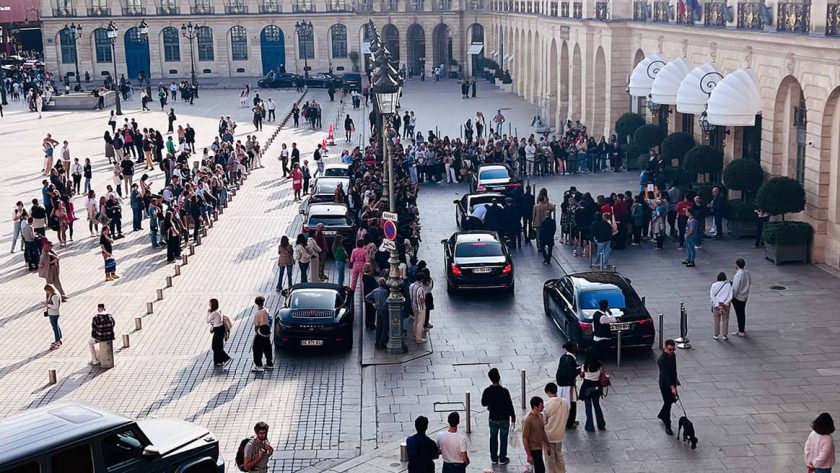Fashion week in Paris went ahead with the renewed activity that it had already seen
in June, bringing forward an impressive number of creative proposals for spring/summer 2024, and
highlighting the power of celebrity business and the return of Asian talent, particularly from
China, where organisations are keen to build bridges with the European market. While the official
Paris Fashion Week calendar included 108 brands, spanning 28 September to 4 October, a total
of around 1,080 other brands presented themselves in showrooms, at trade fairs and in privately organised shows around the city. This justified Paris’ status as the international capital of the fashion business.
Despite this, the much sought-after Paris fashion shows have become relatively inaccessible to certain industry professionals. Following that of journalists, it was now the turn of the buyers to be relegated to the second or even third row, in favour of celebrities or influencers. It’s a strategy that makes perfect sense under the idea that “celebrities are the new business”, a concept we will circle back to later.
Another marketing buzz factor for the SS24 collections was the entry of well-known designers into major fashion houses. For example, after the low-profile wave seen in previous seasons, Louise Trotter’s arrival at Carven caused a stir among buyers.
However, while there was plenty of chatter, the fashion week season is still coming too late. According to Chaco Abou-Jaoude, manager of Romeo showroom: “The June and January periods (normally reserved for men’s ready-to-wear collections) are much more dynamic due to the presentation of the pre-collections. Many buyers regret not being able to come twice in the same season, because of the rise in prices (transport, accommodation, etc.).”
Paris Fashion Week welcomes the return of Asian talent
This was a sentiment shared by Cindy Gout, co-founder of the Likewise showroom, who said: “Almost 80 percent of purchases are made during the pre-collections, in June. Asian buyers don’t stay as long because of the cost of travel. The global market is complicated.”
Created a year ago, LikeWise caters to the increased demand for emerging designers, including those present this season China’s 8on8 and Belgian designer Yomi, or more established names, such as Germanier and Valentine Gauthier. “Asia (namely the countries South Korea, Japan, China) is the number one market for luxury goods,” added Gout. “Japanese buyers are coming back to Paris. Breaking out of their Covid-era conservatism, they are once again looking for creative, cutting-edge products. They work a lot with buying offices based in Paris, but two or three of them come to see the new collections.”
Chinese organisations eye more permanent European fixtures
It was Chinese designers, in particular, that really made a statement for this season, with both buyers and institutions on the roster – be it the city of Guangzhou that helmed its own fashion incubator or the China Fashion Association, which highlighted six exhibitors at PFW’s partner show, Tranoï. At a press conference, Robin Fang, general manager of Shenzhen Oriental Fashion, a strategic hub for high-end fashion, told FashionUnited that he wants to build relationships between France and China.
Fang noted that he was zoning in on the European market, where he hopes to locate a year-round showroom to set up shop in while widening his own country’s doors to welcome French brands, particularly those he believes are lacking commercial opportunities by confining themselves to the West. In Fang’s opinion, the younger generation are growing tired of the big names in luxury and are looking for alternatives.
Another emerging event was the Sino-French Fashion and Culture Festival. Organised at the China Cultural Centre, under the aegis of the country’s government, it brought together brands from the region, while also giving Theunissen, a young French designer, the opportunity to take part in a fashion show, concrete proof of the link that is forming between the two nations. The Chinese authorities are planning to repeat the festival twice a year during PFW.
SS24 moving towards global, conceptualised and marketed brands
Another phenomenon that set the tone for the SS24 season was brands moving out of their chosen territory to capitalise on a more comprehensive range, as seen in features such as an expanded range of differing items. This new trend in the fashion market reflects the evolution beyond specialist multi-brand retail towards concept stores, where lifestyle products sit alongside clothing lines.
“Unless you establish a real style line so that buyers understand what’s on offer, it’s a risky strategy,” warned Patricia Lerat, the CEO of Plc Consulting Paris, who had also noticed a shift at trade shows, many of which have repositioned themselves both in terms of scenography and also how they read current trends following the pandemic. “This is a sign of great energy,” Lerat added.
It’s an energy that will need to be maintained at a time when many buyers become acutely aware of the impending 2024 Olympic Games. This is in light of the aforementioned rising travel costs, and “the prevailing insecurity that goes hand in hand with a retreat to conceptual, marketed labels that know how to produce and deliver on time,” said Xavier Latapie and Giulietta Canu, the duo behind Moddity, a guide that lists many of the events taking place during fashion week.
And all the more so because, contrary to what you might think, the temperatures experienced at the end of September, beginning of October 2023 (minimum 24 degrees in major European cities), has not played in retail’s favour. Stores have already begun integrating autumn/winter collections which, due to the heat, are not selling out, foreshadowing surplus stocks.
In this context, the role of sales staff is more difficult than ever. In the past, buyers waited until PFW to place their orders. Today, they come with their mobile phones, photograph the garments they like, request a lookbook and note down, if interested, the quantities when they get home.
“(Buyers are) so busy that when they reply to our emails, even to say no, it’s a miracle,” said an agent off the record. “When it’s a well-known luxury brand, orders are completed in two days, but for a more lesser-known label that needs to launch production, negotiations can take weeks.” With this in mind, the questions arise: How do you put the spotlight on young designers who don’t feature in the official calendar, yet are considered to be the pride of Paris as a fashion capital? How do you give them a permanent place in the international business landscape?
This article originally appeared on FashionUnited.FR. Translation and edit by: Rachel Douglass.
Note: the number of brands that took part in the official Paris Fashion Week show was 108, not 140 as previously stated. The number of brands presenting their collections off-show is 1,080 (not 1,260).



